Iconic surrealist paintings have captivated art lovers for nearly a century, transforming how we think about reality, dreams, and artistic expression. These extraordinary works emerged from the surrealism art movement of the early 20th century, challenging traditional artistic conventions with their dreamlike imagery and exploration of the unconscious mind. From Salvador Dalí’s melting clocks to René Magritte’s floating green apples, these masterpieces continue to inspire and mystify viewers around the world.
Key Points Summary

- Surrealism emerged in the 1920s as a revolutionary art movement exploring dreams and the unconscious
- Famous surrealist artists like Dalí, Magritte, and Miró created timeless masterpieces still celebrated today
- Iconic surrealist paintings feature dreamlike imagery, unexpected juxtapositions, and symbolic meanings
- These works can be found in major museums worldwide and continue influencing contemporary art
- Understanding surrealist techniques helps viewers appreciate the deeper meanings behind these fascinating artworks
What Made Surrealism Revolutionary?
The surrealism art movement began in Paris during the 1920s, growing out of the earlier Dada art movement. Founded by André Breton, surrealism sought to release the creative potential of the unconscious mind, inspired by Sigmund Freud’s theories about dreams and psychology.
Unlike traditional art that depicted the visible world, surrealist artists painted scenes from their dreams, nightmares, and subconscious thoughts. They used techniques like automatism, where artists would let their hands move freely without conscious control, allowing unexpected images to emerge. This approach to creating art was part of the broader 20th century art movements that challenged conventional artistic practices.
The Most Iconic Surrealist Paintings That Defined an Era
The Persistence of Memory (1931) by Salvador Dalí
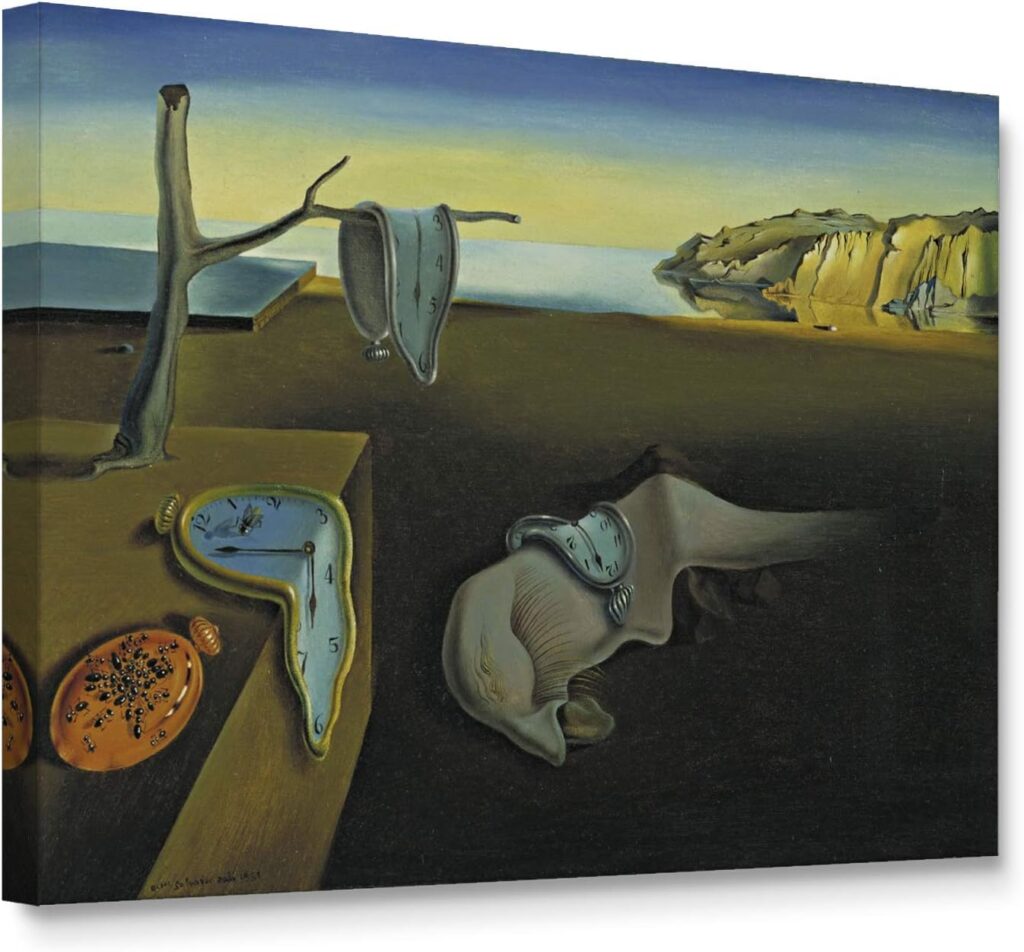
Perhaps the most recognizable of all famous surrealist paintings, “The Persistence of Memory” features Dalí’s famous melting clocks draped over a barren landscape. This oil on canvas masterpiece explores the concept of time in dreams, where our normal understanding of time becomes fluid and meaningless.
The painting shows three melting pocket watches and one orange timepiece covered with ants, set against the cliffs of Port Lligat near Dalí’s home in Spain. The dreamlike quality and precise, photorealistic technique demonstrate why Salvador Dalí paintings remain among the most celebrated surrealist art masterpieces.
The Son of Man (1964) by René Magritte
René Magritte’s “The Son of Man” presents a businessman in a bowler hat whose face is obscured by a floating green apple. This painting perfectly demonstrates Magritte’s exploration of visible and hidden elements, challenging viewers to question what they see versus what they know.
The mysterious quality of this work, with its precise technique and impossible scenario, exemplifies how iconic surrealist paintings use ordinary objects in extraordinary ways. The apple becomes a symbol of forbidden knowledge, while the figure’s anonymity speaks to modern alienation.
Harlequin’s Carnival (1925) by Joan Miró
Joan Miró’s “Harlequin’s Carnival” fills the canvas with whimsical creatures, geometric shapes, and biomorphic forms in vibrant primary colors. This painting represents Miró’s unique approach to surrealism, blending abstract art with fantastical imagery.
The work depicts an imaginary interior filled with musical notes, ladders, eyes on stalks, and playful abstract figures. Miró created this masterpiece during a period of poverty, when hallucinations from hunger influenced his artistic vision, resulting in one of the most joyful and energetic surrealist movement paintings.
Salvador Dalí: Master of Surrealist Art
Salvador Dalí became the most famous face of surrealism through his flamboyant personality and extraordinary technical skill. His “paranoiac-critical method” involved inducing hallucinations and paranoid states to access his subconscious mind for artistic inspiration.
Beyond “The Persistence of Memory,” Dalí created numerous other famous surrealist paintings including “The Metamorphosis of Narcissus” and “Dream Caused by the Flight of a Bee Around a Pomegranate a Second Before Awakening.” His precise, almost photographic painting style made even the most bizarre dream imagery appear convincingly real.
“I don’t do drugs. I am drugs.”
Salvador Dalí
Video: Savador Dali Paintings
René Magritte’s Mind-Bending Reality
René Magritte approached surrealism differently than his contemporaries, focusing on the relationship between images and words, reality and representation. His paintings often feature ordinary objects in impossible situations, challenging viewers’ perceptions.
“The Treachery of Images” (1929), which shows a pipe with the text “This is not a pipe,” perfectly demonstrates Magritte’s intellectual approach to surrealism. Other famous surrealism artists like Magritte used their work to explore philosophical questions about reality, language, and meaning.
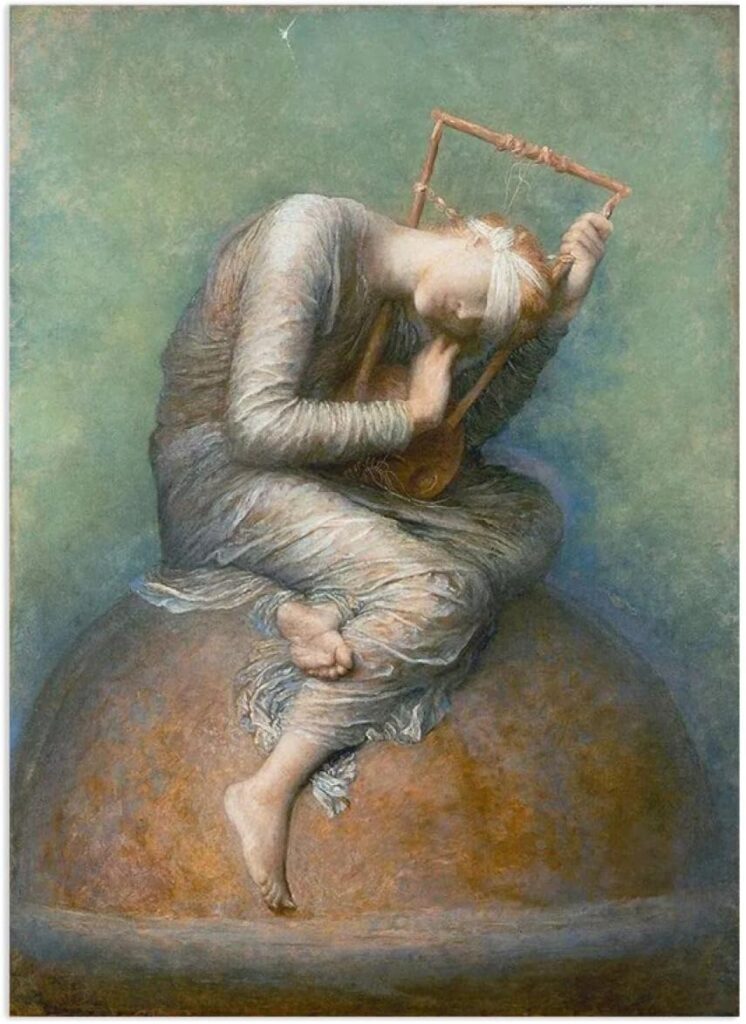
Lesser-Known Surrealist Masterpieces You Should Discover
While Dalí and Magritte dominate popular understanding of surrealism, many other artists created equally compelling works:
Max Ernst pioneered collage techniques in surrealism with “Two Children are Threatened by a Nightingale” (1924), combining painting with three-dimensional elements attached to the canvas.
Giorgio de Chirico’s “The Mystery and Melancholy of a Street” (1914) predated the official surrealist movement but influenced its development with its haunting, empty urban landscapes and dramatic shadows.
Man Ray contributed surrealist photography and paintings like “Le Violon d’Ingres” (1924), which transformed a model’s back into a violin through creative photography techniques.
How to Understand and Appreciate Surrealist Painting Techniques
Understanding surrealist painting techniques enhances appreciation for these complex works. Key approaches include:
| Technique | Description | Example |
|---|---|---|
| Automatism | Allowing the subconscious to guide the creative process | Miró’s spontaneous forms |
| Trompe-l’oeil | Creating incredibly realistic illusions | Dalí’s photographic precision |
| Juxtaposition | Placing unrelated objects together | Magritte’s impossible combinations |
| Metamorphosis | Transforming one object into another | Ernst’s collage techniques |
These techniques help viewers recognize the symbolism in art and understand the hidden meanings in famous paintings. Learning to appreciate art as a beginner becomes easier when you understand these fundamental surrealist approaches.
Where to See Famous Surrealist Paintings Today
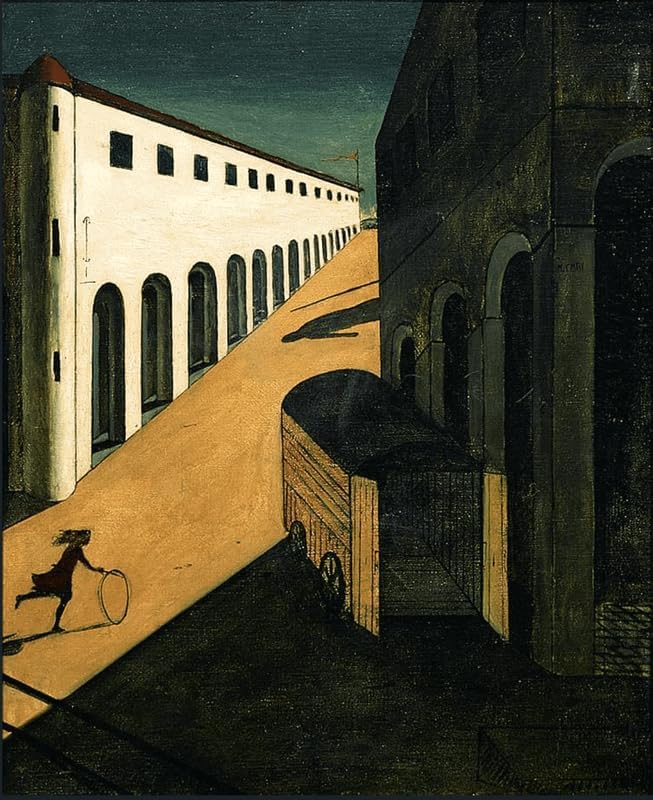
Many iconic surrealist paintings are housed in major museums worldwide:
- Museum of Modern Art (MoMA), New York: Houses extensive surrealist collections
- The Dalí Museum, St. Petersburg, Florida: Dedicated to Salvador Dalí’s works
- Centre Pompidou, Paris: Features European surrealist masterpieces
- Tate Modern, London: Displays international surrealist art
- Metropolitan Museum of Art, New York: Includes surrealist paintings in broader collections
Understanding the diversity of art museums helps art lovers plan visits to see these masterpieces in person. Many museums also host special art exhibitions focusing on surrealism.
The Legacy of Surrealist Art in Modern Culture
The influence of iconic surrealist paintings extends far beyond traditional art galleries. Contemporary artists, filmmakers, advertisers, and designers continue drawing inspiration from surrealist imagery and techniques. The movement’s exploration of dreams, the unconscious mind, and impossible realities resonates strongly in our digital age.
Modern art continues incorporating surrealist elements, while famous artists and their styles show clear connections to surrealist pioneers. The movement’s emphasis on creativity, imagination, and breaking conventional rules remains relevant for today’s artists and art enthusiasts.
Frequently Asked Questions About Surrealist Paintings
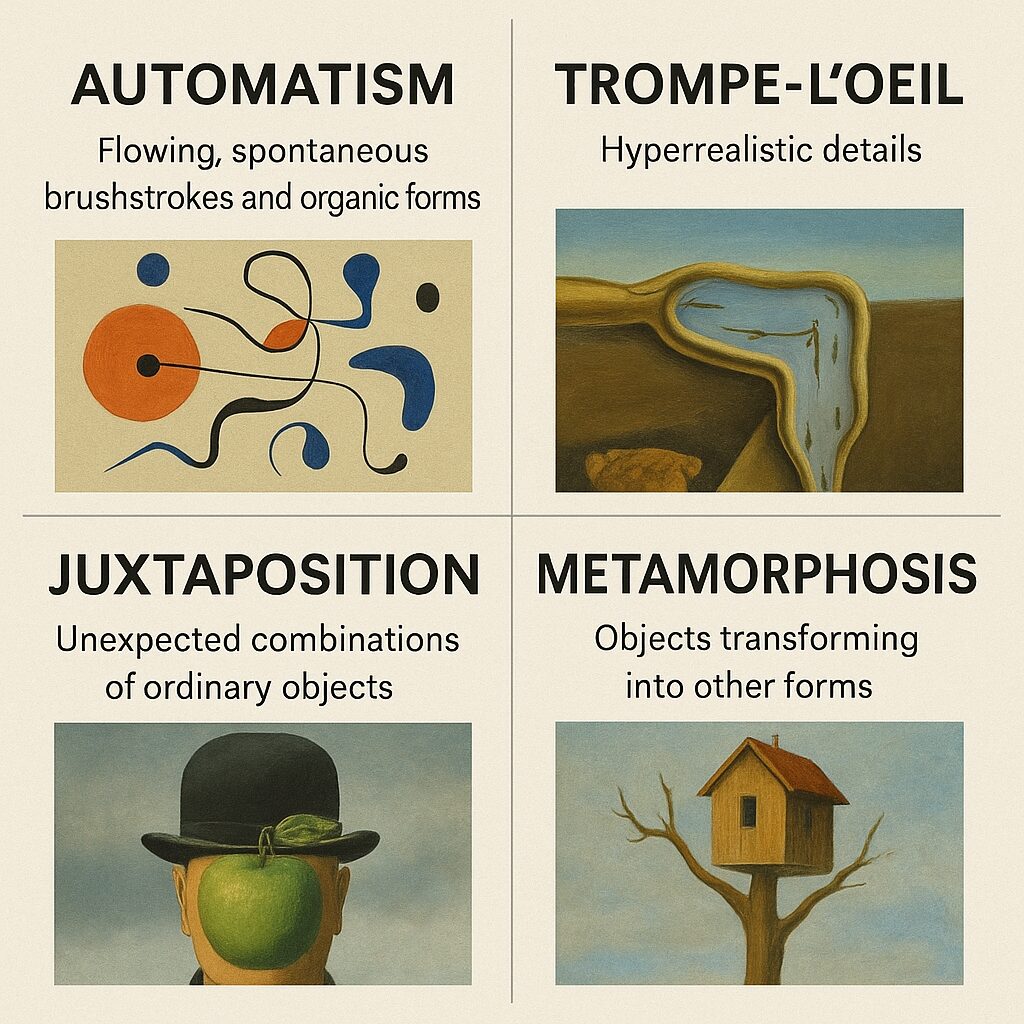
Q: Who were the main surrealist artists? A: The primary surrealist artists include Salvador Dalí, René Magritte, Joan Miró, Max Ernst, Man Ray, Giorgio de Chirico, and André Breton (who founded the movement).
Q: What makes a painting surrealist? A: Surrealist paintings typically feature dreamlike imagery, impossible scenarios, exploration of the unconscious mind, unexpected juxtapositions of objects, and techniques like automatism.
Q: When did the surrealism art movement start? A: Surrealism officially began in 1924 when André Breton published the First Surrealist Manifesto in Paris, though some proto-surrealist works appeared earlier.
Q: How did World War influence surrealist art? A: Both World Wars deeply affected surrealist artists, with many fleeing Europe for America. The trauma and absurdity of war reinforced surrealist themes about the irrationality of modern life.
Q: What inspired surrealist artists? A: Surrealist artists drew inspiration from Freudian psychology, dreams, the unconscious mind, automatic writing, and earlier movements like Dadaism.
Q: How much are original surrealist paintings worth? A: Original surrealist paintings by major artists can be worth millions of dollars, with Dalí, Magritte, and Miró works commanding the highest prices at auction.
Conclusion
The enduring appeal of iconic surrealist paintings lies in their ability to transport viewers into worlds where logic gives way to imagination and dreams become reality. These masterpieces by Dalí, Magritte, Miró, and other visionary artists continue challenging our perceptions and inspiring new generations of creators. Whether you’re viewing “The Persistence of Memory” for the first time or discovering lesser-known gems like Ernst’s experimental collages, famous surrealist paintings offer endless opportunities for contemplation and wonder. Understanding this remarkable art movement enriches our appreciation for creativity’s limitless possibilities and reminds us that art’s greatest power lies in its ability to show us new ways of seeing the world.
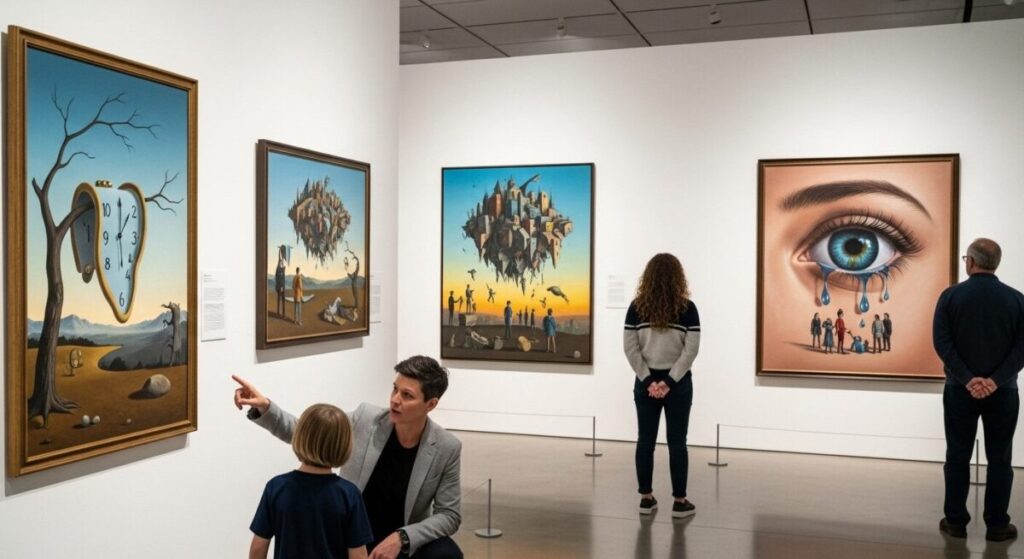
Additional Resources
- The Museum of Modern Art – Surrealism Collection
- Tate Modern – Surrealism Movement Guide
- The Dalí Museum Official Website
- Metropolitan Museum of Art – Heilbrunn Timeline of Art History: Surrealism
- Centre Pompidou – Surrealism Collection
- The Art Story – Surrealism Movement Overview
- Guggenheim Collection – Surrealism



